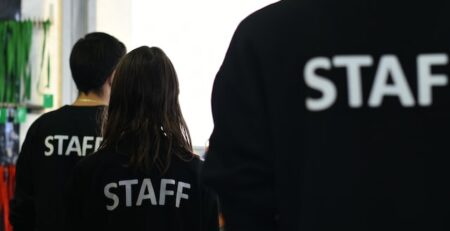10 Signs of Low Employee Morale
Monitoring job morale in the workplace is crucial for retaining and motivating employees, ultimately contributing to a better working environment. Many companies struggle to comprehend this concept, leading them to overlook evident indicators that the work atmosphere is deteriorating.
Employees may experience frustration or unhappiness for various reasons, sometimes solely related to workload rather than any inherent issues with the company itself. To proactively maintain a positive environment and ensure employee satisfaction, it’s essential to recognize when morale is low.
Continue reading to discover the ten most distinct signs that indicate a need to boost employee morale. By addressing these signs, you can enhance job satisfaction, motivate your workforce, and maintain smooth operations.
What is Employee Morale?
Employee morale is a measure of workers’ attitudes, opinions, and dedication to their company and job. It’s not quite a performance metric nor is it quantitative in any way. Employee morale is simply the human element of the workplace.
Unfortunately, a strict definition of this human element hasn’t been established in the research or literature. That’s a significant part of the reason that so many companies don’t pay enough attention to morale or understand how to approach it consciously and effectively.
Morale is more than simply the mood of an employee on a given day. Understanding the current state of employee morale requires a more holistic view of certain trends and how they develop over time. You could say that employee moods in the short-term are like the weather while the employee morale is like the climate.
Common Negative Influences on Employee Morale
When it comes to employee attitudes and happiness, many managers and other decision-makers don’t think beyond salaries and benefits. Granted, the paycheck is a motivator for the vast majority of workers across industries, but it’s also true that people will leave jobs despite a good salary if they’re deeply dissatisfied.
Here are a few of the most common reasons employee morale can fall into a slump.
- Workload
Nothing drives employees toward burnout like a heavy workload. This is particularly true when the duties that are piling up are beyond the scope of the original job description. While coworkers can help, that solution doesn’t apply if everyone is swamped at the same time. Increase job satisfaction overall by doling out work evenly and, where possible, democratically.
The important thing to remember about workload and project assignments is to prevent overly ambitious workers from biting off more than they can chew while simultaneously ensuring that everyone is doing their fair share. The perception that work is not being doled out evenly has just as much potential to be harmful as work overload.

- Work-Life Balance
For many people, a completely backward work-life balance is how they’ll remember the great remote work shift of the early 2020s. No matter how dedicated they are to their job or how passionate they are about the work that they do, nobody wants to be on-call 24/7 without any time to live their normal life. Remote work has blurred the lines between time on and off the clock.
Work-related interference can be pernicious. It’s not only staying late at the office – it’s also unwanted emails, phone calls, and generalized stress. If the business goals are too ambitious, it can leave little time for normal life activities. When work is too stressful, even downtime may be spent dreading upcoming deadlines or decisions.
- Insufficient Tools
If you want creatives and other employees to do certain tasks, you must equip them well enough to do so. Decision-makers who don’t have hands-on experience with creatives frequently have trouble making sure their creative staff has the right tools because of the overwhelming number of software programs and online platforms needed to build great design and web products.
When there’s a knowledge gap on the management team, it’s essential to empower someone with the know-how to make decisions about tools. Get the creatives involved as well to increase job satisfaction and prevent them from feeling stuck without the right tools and no workable solution to solve the problem.
- Lack of Leadership
Just like the software decision we just mentioned, team members should have a clear path to the people who call the shots so they can direct attention to areas where it’s needed. Some small teams at boutique firms prefer to do away with outright hierarchy throughout much of their employees, but there should still be a clear map of responsibilities so workers can bring problems to the right person.
Leadership is also displayed in decisive behavior. Leave employees waiting or unable to progress because management is dragging its feet and they’ll grow exasperated very quickly.
- Professional Roadblocks
A lifelong career with a single company is a thing of the past for many people. This is mainly due to the lack of opportunities for promotion within the same organization. Addressing this problem is a true challenge because it almost always requires a structural solution to make sure the company is using strategies such as insourcing, reskilling, and upskilling to promote from within and motivate employees to stay with the company for the long term.
Providing training materials so employees can bolster their existing skills and learn new techniques in new areas is especially important for creatives. Usually, passion in employees translates into a deep desire to dive further into their trade, so providing them an opportunity to do so will make them much happier. Plus, it’s a huge advantage for the business to have highly skilled employees.
- Office Culture
The atmosphere of a workplace goes beyond the short- or long-term attitudes of the workers. Employees must also interact with each other, clients, and anyone else important to the overall production process of the company’s goods or services. Beyond even that, the general culture of a workplace also involves how everyone feels about the work itself and its impact on the outside world.
Whether the workplace is online or in-person, employees perceive how everyone else on the team is feeling and it affects how they feel about things as well. Culture and morale have significant overlap, but the good news is that they can also be addressed with the same or similar solutions.
- Work Tasks
It should come as no surprise that employees both creative and otherwise want to be satisfied with the particulars of the work that they do. Granted, there will always be plenty of unglamorous tasks that need doing for the business to proceed. But a frank acknowledgment of the circumstances and the presence of other meaningful work that is more central than the mundane tasks will help workers feel fulfilled.
If mundane work simply can’t be avoided, as it usually can’t on some level, then sufficient attention and rewards will help the pill go down more smoothly, so to speak. Make sure this attention and any related rewards are given out evenly.
Everyone doesn’t have to be praised every single time anyone is, but make sure that all who put in hard work see it recognized and rewarded. The perception of uneven attention or unfairness in reward throughout the organization has a huge impact on employee morale and the company culture in general.
10 Tell-Tale Signs of Low Employee Morale
What does it look like when one of these factors is negatively affecting the morale of the workplace? Keep an eye out for some of the following signs that all is not well in the organization.
1- Shoddy Work & Missed Deadlines
The fastest way to notice a decrease in morale is to monitor the productivity and quality of work employees produce. Although it’s not always directly tied to low morale and not something like personal problems or a short-term work overload, monitoring the quality and quantity of production is often the easiest way to notice morale slumps because successful companies are already monitoring both things to make sure business is running smoothly.
You can avoid miscommunication on this subject by determining whether employees care that they’re turning in bad work or finishing projects late. Many times, they’ll be the ones voicing concerns if they aren’t happy with what they’re producing or don’t have enough time and resources to make their best work.
2- No Initiative
Creatives and other workers are usually more than willing to take some action on an idea they come up with themselves. If you notice a lack of proposed solutions or no desire to take responsibility when ideas are proposed, morale is either drooping or already low.
You can imagine how this goes at part-time jobs with little promise of advancement – minimum-wage retail workers will implement directives from management, but they’re less likely to take on additional responsibilities without rewards.
High morale will motivate employees who want the good times to keep rolling.
3- Blame, Jealousy, & Pettiness
All three of these behaviors are much less than ideal in everyday life, to say nothing of work environments. Teamwork is essential for any kind of workplace and this kind of negative interaction is poison in the well.
People who have worked alongside one another for years can turn against one another, but it’s unlikely if the work environment doesn’t promote such behavior. For example, a limited budget might have people competing for bonuses and that’s more likely to lead to sabotage than it is to breed real innovation and imagination.
4- High Turnover Rates
When employees are unhappy, they leave. The office culture might not suit them or they could receive a better offer from another company, but morale will suffer either way. If employees feel they are in a uniquely positive work environment, they will resist leaving even if a slightly higher salary or better benefits are promised elsewhere.
Make sure to keep an eye on the job market to determine whether a high turnover rate is tied to low morale. Sometimes an industry explodes and money is too good to turn down elsewhere. But if you have a significant number of employees leaving, then they didn’t see much reason to stay.
5- Disciplinary Issues
This is a tricky area because overly strict disciplinary measures can cause morale to bottom out unbelievably quickly. In some cases, it can turn into a self-fulfilling prophecy. A manager is worried about employees disobeying and the employees, in turn, become disaffected by stringent disciplinary measures.
Look out for discipline that prevents people from being social with each other or behaving naturally. Very generally speaking, there is very little reason to punish team members of working adults. Corrective measures should be a team effort so that problems are solved.
Everyone who brings money home with work at a company wants that company to succeed for their well-being, so behavioral issues usually have a separate root cause.
6- Exclusionary Behavior
If employees are separating from each other of their own accord, there might be in-fighting or gossip spreading through the office. Remote teams are also more than capable of exclusionary behavior. Look for employees being left out of team efforts and assignments and uneven pairing during group or team-building exercises.
Some common exclusionary behavior happens between seasoned employees and new hires. During the onboarding process, some people resist new talent and don’t bring them into the fold. That’s a clear sign that a few bad apples might be ruining the overall atmosphere of the work environment.
7- Blaming
When teamwork breaks down, employees start blaming one another for real or perceived shortfalls or mistakes. In the worst-case scenario, they may even set one another up for failure and highlight the bad performance of other employees.
On a strong team, accepting blame for others’ mistakes might be more common, but this is also harmful to team efforts generally. The work environment should be comfortable enough for people to acknowledge faults in themselves and others and identify when mistakes are made without shifting blame or cutting one another down.
With this kind of atmosphere, you can motivate employees to work together to solve problems rather than blaming one another and shirking responsibility.
8- Customer Complaints
Customer service is a central feature of every business, even when employees don’t have a typical face-to-face interaction with customers. The people who support your business realize a bad atmosphere when you least expect it. If customers are dissatisfied, they’ll still frequently acknowledge that it’s due to obvious low morale.
Watch how employees react to customer complaints as well. If they’re blaming each other or refusing to take responsibility for a bad customer experience, you should make attempts to boost employee morale.
Increase job satisfaction and boost employee morale by humanly addressing customer complaints. Blame is generally unneeded unless the mistake is particularly egregious.
9- Slumps & Slow-Downs
It’s possible to detect negative moods and productivity slowdowns in remote work and traditional offices. When workers notice before management or they see decision-makers failing to react when a slump does occur, the drop in morale will compound.
The lack of presence of management and decision-makers in workspaces is the fastest way to miss things turning sour. When you make sure management is present, you also increase employees’ ability to reach out and problem solve with decision-makers.
10- Reduced Involvement
Every manager wants employees to be enthusiastic about work activities and team-building exercises, but the fundamental fact is that people can’t always be as eager as they feel. It’s not only on special occasions. Keep an eye and ear out for silent meetings and a lack of participation in new initiatives.
For remote teams, videoconferences are a great way to identify reduced involvement. Of course, the conferences themselves may also be structured so that people don’t want to be involved. If you start hearing complaints that a meeting should have been a phone call, you may want to rethink the structure of your meetings to boost employee morale.

Conclusion:
Increase job satisfaction and you can increase retention rates and motivate employees to produce better work overall. Whether they’re creatives or other employees, you can use the 10 signs in this guide to make sure talent stays happy and concentrated on fulfilling their roles rather than settling petty differences.
Remote work might have made employee morale slightly more difficult to detect, but the same rules apply in both scenarios. Remain open and available for employees so you can boost employee morale when you need to and make the whole office a better place to work.
In today’s competitive market, finding the right creative and marketing expert can be a challenge. But with icreatives, you’re in experienced hands. With 37 years in staffing and a track record of matching more than 10,000 employees to over 1,000 companies worldwide, we know how to connect you with the best. Plus, you only pay if you hire—there’s no risk, only results.
Ready to find your perfect creative or marketing expert? HIRE WITH ICREATIVES today!












